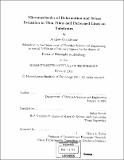| dc.contributor.advisor | Subra Suresh. | en_US |
| dc.contributor.author | Gouldstone, Andrew | en_US |
| dc.contributor.other | Massachusetts Institute of Technology. Dept. of Materials Science and Engineering. | en_US |
| dc.date.accessioned | 2005-08-23T15:17:49Z | |
| dc.date.available | 2005-08-23T15:17:49Z | |
| dc.date.copyright | 2001 | en_US |
| dc.date.issued | 2001 | en_US |
| dc.identifier.uri | http://hdl.handle.net/1721.1/8783 | |
| dc.description | Thesis (Ph.D.)--Massachusetts Institute of Technology, Dept. of Materials Science and Engineering, 2001. | en_US |
| dc.description | Includes bibliographical references (p. 123-129). | en_US |
| dc.description.abstract | In this thesis, we investigated the mechanical behavior of small volume structures, with specific application to thin metal films and patterned metal lines on substrates. The first part of this investigation dealt with the elastoplastic behavior of interconnect lines during thermal cycling. A robust computational method was developed to predict volume-averaged stresses in unpassivated and passivated lines in response to changes in temperature, as a function of line geometry, material properties and thermal history. The computational model also facilitated the extraction of substrate curvature. In addition, a simple analytical method was developed to allow extraction of volume-averaged stresses in unpassivated lines upon yielding due to thermal stresses, via experimental curvature methods. The second part of the investigation involved the systematic nanoindentation of a wide range of FCC single crystals and polycrystals, in bulk and thin film form. For shallow (</= 100 nm) depths, the experimentally obtained P-h curves displayed elastic loading portions alternated with inelastic displacement bursts, for all specimens. The bursts were attributed to dislocation nucleation and motion within the crystal, which occurred when stresses underneath the indenter tip approached the critical shear strength of the material. Theories of dislocation activity were confirmed with planar TEM photos of nanoindented Cu films. In order to examine the atomistics of such phenomena, an experimental 2-D atomic simulation was developed, via an extension of the classical soap bubble raft, to simulate elastic contact and defect nucleation at low loads. Dislocation nucleation inside crystals of low defect density, ostensibly requiring stresses on the order of the theoretical shear strength, was found to occur under blunt indenters, providing a mechanistic justification for bursts observed during nanoindentation experiments. Finally, the experimental nanoindentation results for thin films were analyzed in the context of elastoplastic indentation, incorporating elastic loading and inelastic bursts. Stiffnesses thus obtained were found to increase as film thickness decreased, displaying a similar trend to literature thin film strength values obtained via substrate curvature methods. | en_US |
| dc.description.statementofresponsibility | by Andrew Gouldstone. | en_US |
| dc.format.extent | 129 p. | en_US |
| dc.format.extent | 12377150 bytes | |
| dc.format.extent | 12376907 bytes | |
| dc.format.mimetype | application/pdf | |
| dc.format.mimetype | application/pdf | |
| dc.language.iso | eng | en_US |
| dc.publisher | Massachusetts Institute of Technology | en_US |
| dc.rights | M.I.T. theses are protected by copyright. They may be viewed from this source for any purpose, but reproduction or distribution in any format is prohibited without written permission. See provided URL for inquiries about permission. | en_US |
| dc.rights.uri | http://dspace.mit.edu/handle/1721.1/7582 | |
| dc.subject | Materials Science and Engineering. | en_US |
| dc.title | Micromechanics of deformation and stress evolution in thin films and patterned lines on substrates | en_US |
| dc.type | Thesis | en_US |
| dc.description.degree | Ph.D. | en_US |
| dc.contributor.department | Massachusetts Institute of Technology. Department of Materials Science and Engineering | |
| dc.identifier.oclc | 48172017 | en_US |
